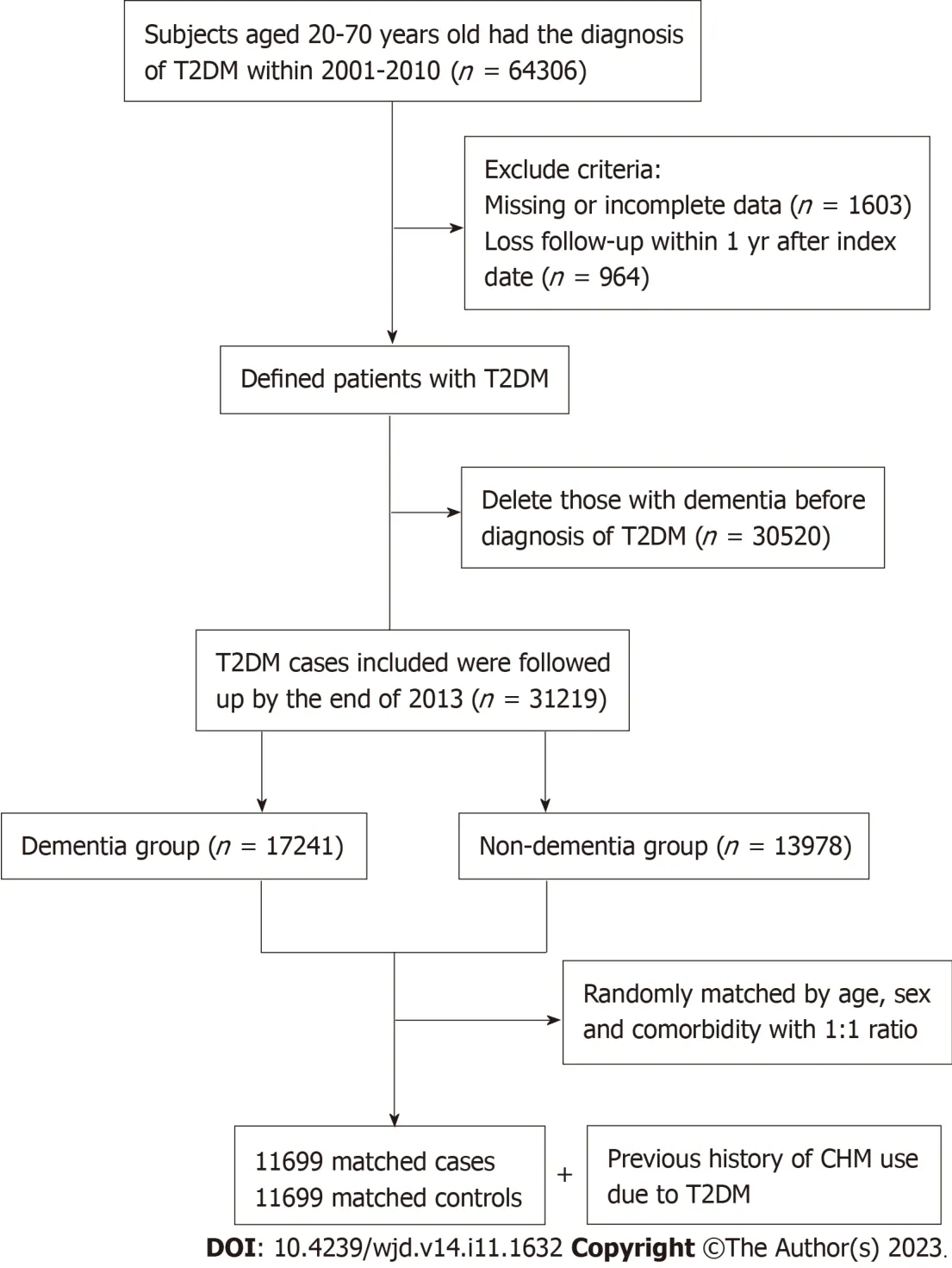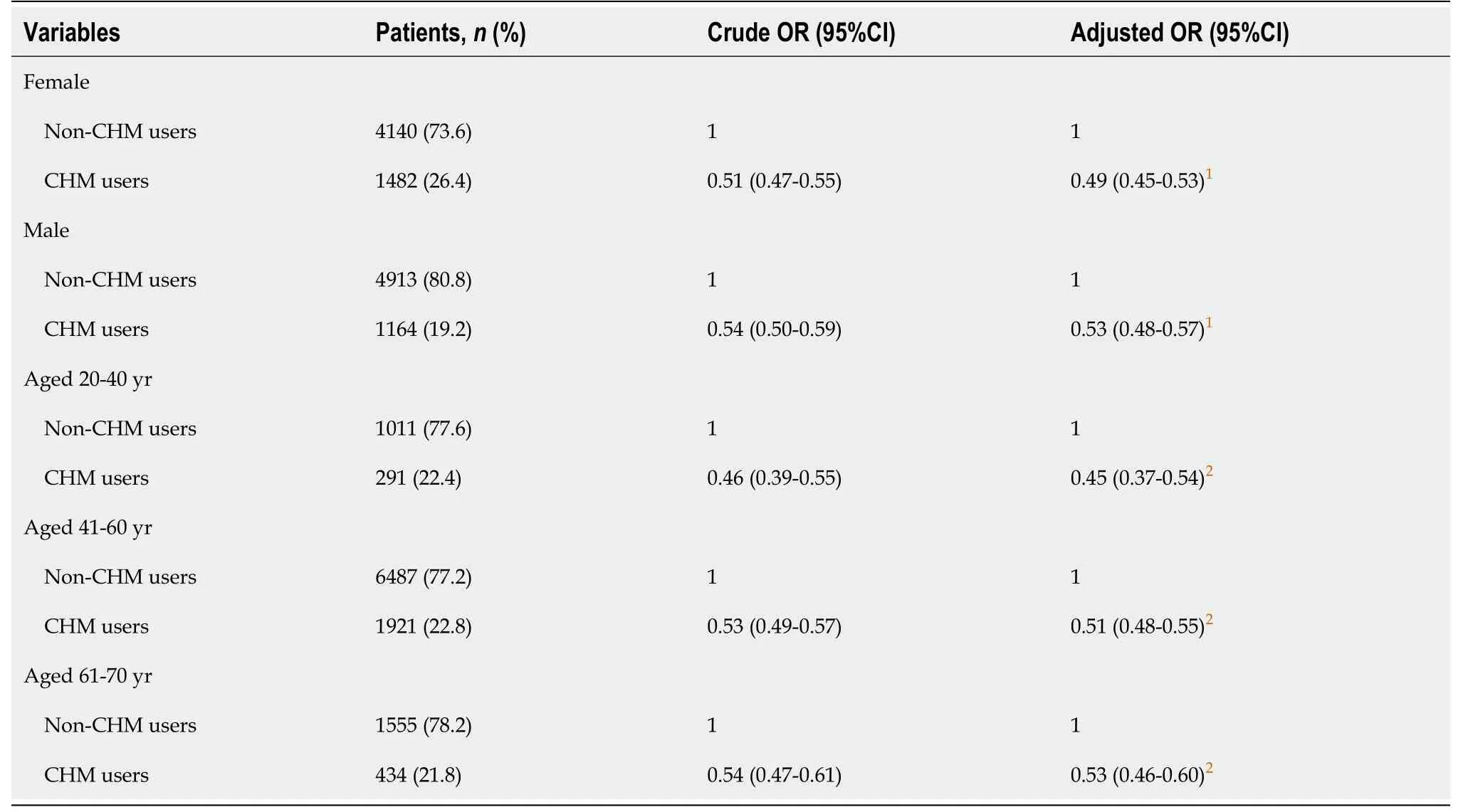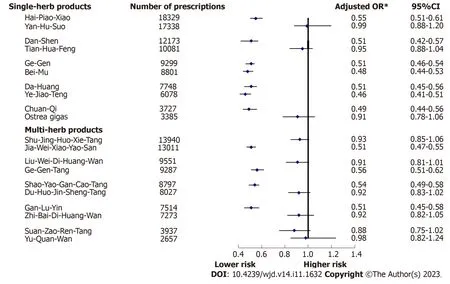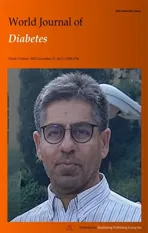Reduced risk of dementia in patients with type 2 diabetes mellitus using Chinese herbal medicine: A nested case-control study
2023-11-26HouHsunLiaoHanochLivnehHuaLungHuangJuiYuHungMingChiLuHowRanGuoTzungYiTsai
Hou-Hsun Liao,Hanoch Livneh,Hua-Lung Huang,Jui-Yu Hung,Ming-Chi Lu,How-Ran Guo,Tzung-Yi Tsai
Abstract BACKGROUND Dementia is a prevalent condition in type 2 diabetes mellitus (T2DM) patients.While Chinese herbal medicine (CHM) is often employed as complementary therapy for glycemic control,its effect in controlling likelihood of dementia has not yet been fully elucidated.AIM To compare the risk of dementia between T2DM patients with and without CHM treatment.METHODS We undertook a nested case-control study and obtained data on patients 20-70 years of age who received medical care for T2DM between 2001 and 2010 from the National Health Insurance Research database in Taiwan.Cases,defined as those with dementia that occurred at least one year after the diagnosis of T2DM,were randomly matched to controls without dementia from the study cohort at a 1:1 ratio.We applied conditional logistic regression to explore the associations between CHM treatment and dementia.RESULTS A total of 11699 dementia cases were matched to 11699 non-dementia controls.We found that adding CHM to conventional care was related to a lower risk of dementia [adjusted odds ratio (OR)=0.51],and high-intensity CHM treatment was associated with an adjusted OR of 0.22.CONCLUSION This study shows that the cumulative CHM exposure was inversely associated with dementia risk in an exposureresponse manner,implying that CHM treatment may be embraced as a disease management approach for diabetic patients to prevent dementia.
Key Words: Type 2 diabetes mellitus;Dementia;Chinese herbal medicine;Nested case-control study;Odds ratio
lNTRODUCTlON
Chronic illnesses are a leading cause of present-day morbidity and mortality,thereby thwarting the healthcare system worldwide.Taking diabetes as an example,a report from the Centers for Disease Control showed that nearly 40 million Americans had diabetes in 2019,and nearly 95% of whom have type 2 diabetes mellitus (T2DM)[1].In such a case,the disease may profoundly affect patients,their families,and society at large.By one estimate,the annual medical expenditures per T2DM patient in the United States was $16752 yearly,which was approximately 2.3 times higher than the average cost for a person without T2DM ($7151)[2].The total national costs imposed by diabetes were expected to rise as well,from $322 billion in 2012 to $404 billion in 2017,an increase of 25% over the past several years[3].
Although recent medical innovations have greatly improved the prognosis of T2DM,its impact is still challenging for the survivors,especially regarding onset of dementia,which may cause serious long-term health problems.Unfortunately,dementia is a silent illness and thus affected persons may be unaware of their cognitive impairment.An earlier meta-analysis of 29 prospective observational studies reported a risk for all-cause dementia among T2DM patients as high as 73%[4].Notably,T2DM patients experience twice the risk of dying after experiencing comorbid dementia[5,6].Recent studies have presumed a link between T2DM and dementia that may include systemic insulin resistance and increased levels of circulating pro-inflammatory markers,both of which would lead to defects in insulin signaling pathway and changes in brain synaptic plasticity,thereby inciting chance of dementia[7].Given the prominence of dementia in the patients with T2DM[5],it is critical to attenuate the likelihood of dementia while managing people with T2DM.
Today,Chinese herbal medicine (CHM) is often employed in treating a broad range of health conditions.Several active CHM ingredients were established to introduce favorable prognoses among patients with inflammatory conditionsviathe regulation of specific circulating cytokines[8].For example,Du-Huo-Ji-Sheng-Tang,one of CHM formulae used for bone diseases treatment clinically,has been proven to suppress the expression of cytokines by abating nuclear factor kappa beta (NF-κB) signaling[9],as well as inhibit several inflammatory mediators known to be involved in the pathogenesis of neurodegenerative illnesses[10,11].In view of a growing body of evidence manifesting that abnormal inflammatory responses may be involved in the pathogenesis of T2DM and dementia[7,12],CHM may be a useful approach to prevent or delay onset of dementia among such groups.
After a thorough literature review,we found no studies that reported data on the association of CHM use with the probable subsequent dementia among T2DM patients.Accordingly,we carried out a nested case-control study based on a nationwide claims database to clarify this issue.Data from such a study would provide valuable information on the compatibility and clinical application of CHM,enabling healthcare providers to institute a more appropriate treatment for T2DM patients.
MATERlALS AND METHODS
Study design and data source
This nested case-control study was conducted using patient records from a national claim data held by the Bureau of National Health Insurance (NHI) in Taiwan[13].As participation in this insurance is compulsory,more than 99% of the healthcare providers have contracted with NHI so far.The implementation of national insurance program would enable the residents to access the cost-effective and quality health care[13].All analytical data were obtained from the Longitudinal Health Insurance Database between 2000 and 2013,which included the original claims data of 1 million insurants randomly extracted from all beneficiaries under the NHI program.This database holds the information on demographics,diagnoses,prescriptions,referrals,hospitalization for these patients covered by the NHI program.This work has been approved by the facility’s institutional review board (No.B10004021-3).The institutional review board also waived the need for informed consent since the raw data used was on the basis of a retrospective claims data with encrypted attribution.
Underlying cohort establishment
Medical diagnoses and procedures in this claims database were recorded with the International Classification of Diseases,9thRevision,Clinical Modification (ICD-9-CM).In accordance with the earlier rule[14,15],the present study recruited patients 20-70 years of age with T2DM who had at least three outpatient or a single inpatient claim with the ICD-9-CM code 250 between 2001 and 2010.Considering the temporal relationship for casual inference,we excluded patients with T2DM who had been diagnosed with dementia before or within 1 year after the onset of T2DM.Consequently,cases of this study had their first diagnosis of dementia during 2002-2013.Additionally,the primary outcome,namely incident dementia,was defined as having the first diagnosis of dementia (ICD-9-CM codes of 290,294 and 331).To ensure the validity,only those diagnosed with dementia who had at least three outpatient service claims within one year,or at least 1 inpatient hospitalization claim were selected[16].Date of when first dementia occurred was deemed the index date.We also employed one-year washout period to exclude the cases if they had any medical visits of dementia before T2DM (n=30520),as well as those who had missing values or were followed up for less than one year after cohort entry (n=2567);in sum,a total of 31219 new-onset T2DM patients were included.
Ascertainment of case and control groups
Among the recruited patients with T2DM,17241 (55.2%) developed dementia before the end of 2013.Each case with dementia was randomly matched to one control who was not diagnosed with dementia,determined by age (within 2 years),sex,and comorbidities.Each member from the control group was assigned the same index date as the corresponding case with dementia,thus keeping a comparable probability of dementia onset during the follow-up period for each group.The flowchart of the study participants’ selection is summarized in Figure 1.

Figure 1 Flowchart of patient screening. T2DM: Type 2 diabetes mellitus;CHM: Chinese herbal medicine.
Assessment of CHM exposure
Firstly,to identify individual exposure of CHM treatment,we reviewed the overall treatment records that occurred from cohort entry to index date.Based on former criteria[17,18],those receiving CHM treatment for more than 30 d due to T2DM were considered CHM users,whereas those who only seek healthcare from Western medical doctors were deemed non-CHM users.All participants were further classified into four groups,non-CHM use (< 31 d),low-intensity use of CHM (31-365 d),medium-intensity use of CHM (366-730 d),and high-intensity use of CHM (731 d or more) based on their cumulative days of CHM prescriptions.This approach would allow us to carefully determine the exposure-response effect of CHM in preventing dementia.
Information regarding covariates
Covariates in the statistical analysis included age,sex,monthly income,prior comorbidities,and urbanization of individual residential area.With regard to monthly income,we utilized the NHI premium payment as a proxy and transformed this indicator into a 3-level ordinal variable as follows: USD ≤ 623,624-1394,and ≥ 1395[19].Furthermore,the urbanization degree was classified into three types of settlements based on a previous study,which comprised cities,towns and semi-dense areas,and rural areas[20].Baseline comorbidities were identified as occurring within one year preceding T2DM onset,and all of them were calculated by the established Charlson-Deyo comorbidity index (CCI)[21].
The Deyo-adapted CCI incorporates 17 diseases,each which is rated on the scale of 1-6,with higher total scores indicating more severe burden due to comorbidities.
Analysis
In all comparisons,aPvalue < 0.05 was considered statistically significant.About the descriptive statistics,we reported continuous variables using mean ± SD,and categorical variables using frequency and percentage.Theχ2test was used to determine differences in percentages of categorical variables,and student’st-test was adopted to evaluate differences in the means between two groups.Univariate and multivariate conditional logistic regressions were then applied to estimate odds ratio (OR) with 95% confidence intervals (CI) for association between CHM usage and sequent dementia.Subgroup analysis stratified by sex and age was performed as well.Sensitivity analysis,after excluding medical comorbidities,was conducted to determine the independent effect of CHM exposure on subsequent dementia risk.All of the analyses were carried out using SAS Version 9.3 for Windows (SAS Institute Inc.,Cary,NC,United States).
RESULTS
A total of 11699 matched pairs of T2DM patients with and without dementia were identified from the cohort dataset.Male patients dominated the number of studied cases and matched controls.Mean age for the total sample was 51.6 years,with a mean follow-up period of 5.8 years.Also,nearly sixty percent of the participants were at the meddle income level and lived in cities.No significant baseline differences in terms of demographic data or comorbidities between two groups were detected.Details of the relevant variables at baseline were shown in Table 1.
During the study period,22.6% of the cases and 35.6% of the controls had a history of CHM use.In the multivariate analyses of CHM use and dementia risk,we observed that those who had a history of CHM use exhibited a 49% reduced risk of dementia,in comparison to those who never used CHM (adjusted OR=0.51;95%CI: 0.48-0.53).Furthermore,those with high-intensity CHM treatment appear to have benefitted by attenuation of likelihood of dementia,which implied an exposure-res-ponse inverse association between duration of CHM use and dementia risk (Table 2).This exposureresponse association still persisted following stratification by sex and age (Table 3).After excluding medical comorbidities as covariates,the sensitivity analysis revealed CHM usage was still tied to a lower risk of dementia,with an adjusted OR of 0.59 (95%CI: 0.51-0.69).Figure 2 displays the top-ten most commonly prescribed single-herb and multi-herbformulae for the treatment of T2DM,along with their associated OR.Uses of certain CHM products appeared to be correlated with a lower risk of dementia,which included Da-Huang,Hai-Piao-Xaio,Dan-Shen,Ge-Gen,Ye-Jaio-Teng,Bei-Mu,Chuan-Qi,Jia-Wei-Xiao-Yao-San (JWXYS),Ge-Gen-Tang (GGT),Shao-Yao-Gan-Cao-Tang (SYGCT),and Gan-Lu-Yin (GLY).

Table 2 The association between dementia onset and use of Chinese herbal medicine among type 2 diabetes mellitus patients

Table 3 Risk of dementia among type 2 diabetes mellitus patients with and without exposure to Chinese herbal medicine use stratified by sex and age

Figure 2 Risk of dementia in relation to the ten commonly used single-herb and multi-herb products for subjects. OR: Odds ratio;CI: Confidence interval.
DlSCUSSlON
There is accumulating evidence manifesting that T2DM may elevate the risk of cognitive impairment,including dementia,due to the shared pathogenesis between the two diseases[7,12].With no prophylactic options for dementia currently available for T2DM patients,CHM may provide a promising approach on the basis of suggestions drawn fromearlier research[8,9].
As of now,no study has been conducted to explore the long-term effect of CHM on the prevention of dementia among T2DM patients.The multi-variate regression in this study showed that receiving CHM in addition to conventional treatment was associated a 49% reduction in the risk of dementia (OR=0.51),as compared to those without the use of CHM.Longer duration of CHM treatment was found to be associated with greater reduction in dementia risk,independent of gender and age.Specifically,receiving CHM treatment for more than two years was associated a 78% reduction in the risk of dementia (OR=0.22).Despite a lack of comparable studies,the observed beneficial impact of CHM in preventing cognitive decline may contribute to a growing body of evidence indicating the clinical efficacy of CHM among individuals with chronic diseases[22,23].We postulate that some herbal products may provide effective synaptic concentrations of monoamines for modulating hippocampal neurogenesis[24],hence supporting the positive impact of CHM shown in this research.For example,we found that usage of Hai-Piao-Xiao was associated with a reduced the risk of dementia,echoing an earlier study showing that this herb possessed a neuroprotective properties[25].Another study described that extracts of Hai-Piao-Xiao slowed down lipid oxidation by chelating ferrous ions[26].It is well known that oxidative stress is not only involved in the development of T2DM,but also in cognitive impairment[27].Additionally,the elevated oxidative stress gradually triggered the release of neuroinflammatory cytokines and deposition of amyloid-â-peptide (Aâ),thus provoking development of dementia[4].The prescriptions of Dan-Shen and Ge-Gen were associated with a decreased risk of dementia herein.Some animal models found that these two remedies could possibly elicit neurotherapeutic effects by inhibiting Aâ production and accumulation,thus decreasing the expression of proinflammatory cytokines[28,29].
We found those who received Ye-Jiao-Teng or Chuan-Qi experienced a nearly 50% lower risk of dementia compared to controls.An earlier murine model portrayed that the root of Ye-Jiao-Teng could downregulate nitric oxide and proinflammatory cytokines,such as tumor necrosis factor-á and interleukin (IL)-6,by abating NF-κB signaling[30];both of these products had been implicated in triggering episodes of neurodegeneration.As for Chuan-Qi,recent pharmacological studies argued that the main component of this herbal formula has beneficial impact on the cardiovascular system through inhibition of pro-inflammatory mediators,such as IL-6 and matrix metalloproteinase-3[31,32].These parameters are known to trigger cognitive dysfunction and decline[10].
Our findings also suggest that Bei-Mu and Da-Huang reduce the risk of dementia in T2DM patients.Emodin,an extract from Da-Huang,has been notedin vitroandin vivoto exert anti-inflammatory effect through restraining the NFκB and p38MAPK pathways[33],which play key roles in regulating inflammatory cytokines and cellular reactions to stress[12].Moreover,the effect of emodin on brain-derived neu-rotrophic factor (BDNF) could be responsible for its neuroprotective effects.Beneficial impact of emodin on neurological disorders may be related to the activation of intracellular signaling pathways,such as BDNF/tropomyosin receptor kinase B signaling[34].
Of the commonly used multi-herb products to treat T2DM,we noticed that the prescriptions of SYGCT and JWXYS were correlated with reduction of dementia risk.One recent report posited that SYGCT might regulate the inflammatory state in a murine model by lessening the activation of Toll-like receptor 4/NF-κB signaling pathway[35].The suppression of this pathway has been proven to inhibit Aâ-induced oxidative stress and inflammation[36],thus modifying risk of mitochondrial abnormalities[37].JWXYS is often prescribed to relieve emotional and neuropsychological disorders in clinical practice,and its pharmacologic benefits in preventing dementia have been explored in animal studies.For example,Shenet al[38] noted that Angelica sinensis,a major compound in JWXYS,may enhance synaptic plasticity and upregulate the expression of hippocampal BDNF in depressed rats,induced by mild,chronic,and unpredictable stress.This herb can also inhibit abnormal tau phosphorylation,regulate the release of Aâ peptides,and decrease Aâ-induced neurotoxicity[39,40].These underlying mechanisms may account for the positive impact of JWXYS found herein.
We also identified the benefit of GLY in reducing the subsequent predisposition to dementia among T2DM patients.As a classic CHM,GLY has been proven to exert the anti-inflammatory effect through the NF-κB dependent pathway[41].Furthermore,in vivoresearch has shown that pretreatment of high glucose-stimulated cultured human umbilical vein endothelial cells with baicalin and baicalein,two flavonoids derived from GLY,remarkably inhibited glucose-induced inflammatory responses that mediate vascular permeability and production of reactive oxygen species (ROS)[42].Activation of ROS may cause neuroinflammation that incites the Aâ generation[43].We also noticed the positive effect of GGT in reducing dementia.Former evidence has shown that mice fed with GGT had profoundly lower levels of inflammatoryinduced cytokines,as compared to untreated controls.Its anti-inflammatory effect may be correlated with downregulation of NF-κB/p65 activation and the inhibition of NF-κB activity[44].
Despite being a pioneer study in exploring the effect of CHM on the risk of developing dementia in T2DM patients,this study should be considered in the context of several limitations.First,data used in this work were extracted from a claims-based database;accordingly,the information regarding biochemical data,family history,lifestyle behaviors,and body weight were not available.Thus,residual confounding by these factors might exist to partly bias the association herein.A larger cohort of T2DM patients created by prospective randomized trials,therefore,should be employed to further explore the potential mechanisms underlying the clinical benefits of CHM in preventing cognitive impairment.Second,participants in this study were assigned a diagnosis based on the ICD-9-CM coding only,which may carry a risk of inaccurate indication of true disease status.Thus,misclassification is possible.To deal with this issue,we recruited only those patients with either dementia or T2DM after they were recorded as having at least three outpatient claims or one inpatient record that indicated consistent diagnoses.It should also be acknowledged that the probability of exposure being misclassified was independent of disease status,and the probability of disease status being misclassified was independent of exposure status,which in turn may lead to an underestimate (dilution) of the true strength of an association between exposure and disease[45].Third,information on T2DM severity was not available from the database,and failure to consider this factor might affect the veracity of the findings.As a result,we performed a sensitivity analysis in which we included the T2DM patients with no comorbidities only.This analysis indicated that those receiving CHM therapy still experienced a lower risk of dementia than the controls by 40%,which implied that the observed results were unlikely to be influenced by disease severity.Notwithstanding these limitations,this work is reflective of a populationbased investigation that evaluates the association of CHM use with dementia risk among T2DM patientsviaa nationwide health claims program,thus leaving little room for non-response or loss to follow-up.Another strength of this work is the long observation period.Facing with dementia being a major contributor to disability and the need for care,we had the advantages coming with the over 10-year observation period and the large sample size,which contributed to a better understanding of the link among diabetes,dementia and the benefits of CHM.Lastly,the nested case-control approach used is a rival alternative to a cohort analysis when studying time-varying exposure,such as patterns of drugs or treatments.Hence,the evidence from our study,using real-world health claims,may be comparable to findings derived from medical research using randomized controlled trials.
CONCLUSlON
This population-based nested case-control study found that during conventional treatment for T2DM,the integration of CHM was associated with a reduction in the risk of deme-ntia by 49%.Moreover,the duration of CHM use had an inverse exposure-response association with the risk of dementia among T2DM patients.These findings suggested that a complementary therapy,specifically CHM,may contribute to the disease management of cognitive decline.Not only that,the results of our study further identified certain commonly prescribed herbal products that might be likely to lower dementia risk,hence paving the way for further pharmacological research to cure and control other health maladies.As far as clinical practice is concerned,we recommend that clinicians and people living with diabetes be aware of the increased risk of developing dementia and be vigilant in watching for early symptoms of this disease,so that appropriate diagnostic tests along with provable treatments could be administered when early symptoms of these conditions become observable.
ARTlCLE HlGHLlGHTS
Research background
Over the last several years,patients afflicted with type 2 diabetes mellitus (T2DM) were found to have a nearly double likelihood of having dementia as compared to those without T2DM,which may take a critical toll on their health conditions.
Research motivation
Though the widespread use of Chinese herbal medicine (CHM) in the diabetic patients,to the knowledge of the authors,no population-level study has so far been done to assess if CHM use could be a potential disease management program in lowering risk of dementia among patients with T2DM.
Research objectives
To address this issue,a nested case-control study,aimed to compare dementia risk in T2DM patients with and without the use of CHM,was undertaken.
Research methods
Using a nationwide health insurance database,we identified incident patients diagnosed with T2DM between 2001 and 2010.Among them,each case,defined as who suffered from dementia occurring at least one year after T2DM onset,was randomly matched to one control without dementia.Relationship between CHM use and the risk of dementia was estimated by end of 2013 and evaluated using conditional logistic regression.
Research results
A total of 11699 dementia patients 20-70 years of age,were matched to 11699 non-dementia controls.Among them,use of CHM was correlated to a lower dementia risk (adjusted odds ratio=0.51,95% confidence interval: 0.48-0.53).Notably,those receiving high-intensity use of CHM had a 78% reduced the risk of dementia.
Research conclusions
Findings of this study indicated that add-on CHM formulae as part of T2DM care may be a potential treatment in preventing incident dementia.
Research perspectives
A large cohort of diabetic patients created by randomized trials are warranted to further explore the potential mechanisms underlying the clinical benefits of CHM on prevention of cognitive impairment.
ACKNOWLEDGEMENTS
This study obtained data from the National Health Insurance Research Database provided by the Bureau of National Health Insurance,managed by the Department of Health and Welfare,Taiwan.The main mission of the authority is to ensure the universal participation and equal opportunity of medical care.The interpretation and conclusions contained herein do not represent those of the Bureau of National Health Insurance,Department of Health,or National Health Research Institutes.
But the princess had better have kept silence, for her words made her husband s heart burn within him, and he longed to try his strength against the witch s cunning
FOOTNOTES
Co-corresponding authors:How-Ran Guo and Tzung-Yi Tsai.
Author contributions:Liao HH,Livneh H,and Huang HL contributed equally to this work.Liao HH,Livneh H,and Huang HL were involved in the study design and drafted the manuscript;Livneh H,Lu MC and Tsai TY contributed to data analysis and revised the manuscript;Liao HH,Livneh H,and Hung JY contributed to the interpretation of data and provided comments on the final draft of the manuscript;Lu MC provided administrative support;Guo HR and Tsai TY were not only involved in design and conduct of the study,but also contributed to the software and validation of data;and all authors gave final approval of the version to be published,and agree to be accountable for all aspects of the work.
lnstitutional review board statement:This work has been approved by the facility’s institutional review board (No.B10004021-3).
lnformed consent statement:The institutional review board waived the need for informed consent since the raw data used were on the basis of a retrospective claims data with encrypted attribution.
Conflict-of-interest statement:All the authors report no relevant conflicts of interest for this article.
Data sharing statement:The data that support the findings of this study are available from the corresponding author upon reasonable request.
STROBE statement:The authors have read the STROBE Statement-checklist of items,and the manuscript was prepared and revised according to the STROBE Statement-checklist of items.
Open-Access:This article is an open-access article that was selected by an in-house editor and fully peer-reviewed by external reviewers.It is distributed in accordance with the Creative Commons Attribution NonCommercial (CC BY-NC 4.0) license,which permits others to distribute,remix,adapt,build upon this work non-commercially,and license their derivative works on different terms,provided the original work is properly cited and the use is non-commercial.See: https://creativecommons.org/Licenses/by-nc/4.0/
Country/Territory of origin:Taiwan
ORClD number:Hanoch Livneh 0000-0001-5149-1717;Ming-Chi Lu 0000-0001-9051-0351;How-Ran Guo 0000-0003-3343-3446;Tzung-Yi Tsai 0000-0002-9865-7101.
S-Editor:Wang JJ
L-Editor:A
P-Editor:Wang JJ
杂志排行
World Journal of Diabetes的其它文章
- Cellular and molecular overview of gestational diabetes mellitus: ls it predictable and preventable?
- Exploring the targets and molecular mechanism of glycyrrhetinic acid against diabetic nephropathy based on network pharmacology and molecular docking
- Molecular targets and mechanisms of Jiawei Jiaotai Pill on diabetic cardiomyopathy based on network pharmacology
- Vascular endothelial growth factor B improves impaired glucose tolerance through insulin-mediated inhibition of glucagon secretion
- Molecular mechanisms of noncoding RNA and epigenetic regulation in obesity with consequent diabetes mellitus development
- Mechanisms of action of natural products on type 2 diabetes
